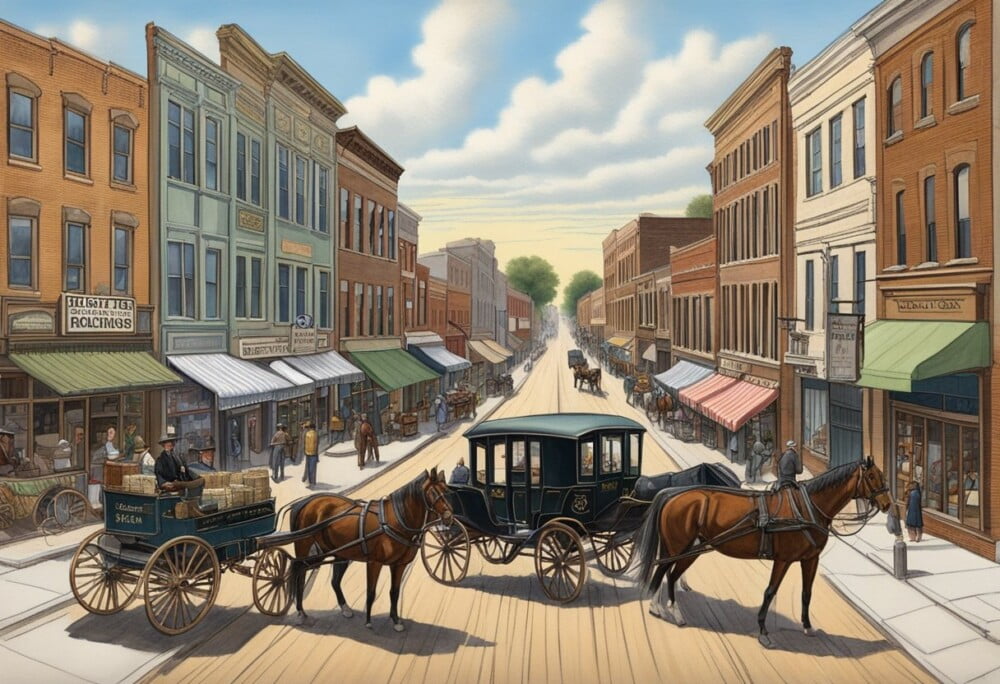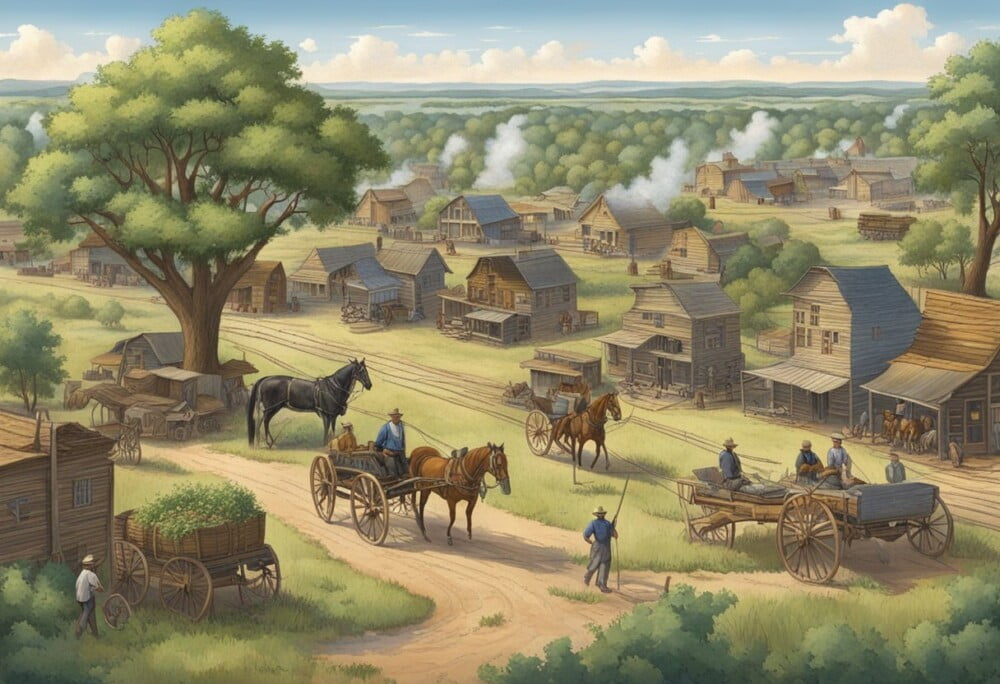by Ray Roman Updated on Dec 29, 2023
Durant, Oklahoma, is a city wrapped in both historical significance and cultural substance, serving as the headquarters of the Choctaw Nation and the seat of Bryan County.
Formally recognized as part of the United States through the Louisiana Purchase and subsequent treaties, Durant was once contested land claimed by European powers before its incorporation into the southern Indian Territory in the 19th century.
Through strategic geography at the crossroads of major highways and rail lines, the city grew from a small community into an important regional hub.

Throughout its history, Durant, affectionately known as the “Magnolia Capital of Oklahoma,” has balanced the growth of educational institutions with economic development, leading to a rich, multifaceted character.
The establishment of the first state-supported school, the Southeastern Normal School, later known as Southeastern Oklahoma State University, marked a major transition in the city’s focus towards education and social progress.
Commerce flourished with the arrival of the Missouri-Kansas-Texas Railroad, fostering a business-friendly environment that catalyzed Durant’s transition into a modern city.
Key Takeaways
- Durant’s history is rooted in the Choctaw Nation’s heritage and significant land treaties.
- Strategic location and transportation were catalysts for Durant’s development.
- The city has a strong educational foundation and a history of progressive economic growth.
Early History

In the early narrative of Durant, Oklahoma, you’ll discover a transition from indigenous habitation to European settlement, reflecting the broader story of the American West.
Indigenous Peoples
Before European contact, the area of Durant was part of a region inhabited by the Choctaw Nation. The Choctaw people were indigenous to the Mississippi River Valley, but following the Treaty of Dancing Rabbit Creek, many were relocated to what is now Oklahoma during the 1830s in the Trail of Tears.
Durant later became part of the Choctaw Nation’s allocated territory in the southern Indian Territory.
European Settlement
Durant’s beginnings as a European-American settlement can be attributed to the arrival of the Missouri-Kansas-Texas Railroad, known as the Katy Railroad, in the 1870s. In 1873, Dixon Durant, a businessman and a minister, is recognized for establishing the town’s first commercial enterprise—a wooden store.
The establishment of “Durant Station” played a pivotal role in attracting settlers and shaping the town’s early economic landscape.
Development of Durant
Durant, Oklahoma, emerged through developments pivotal to its growth, particularly railroad expansion and agricultural beginnings that established it as an economic hub in the region.
Railroad Expansion
Dixon Durant, the town’s namesake, erected its first building in 1873, marking the dawn of Durant’s settlement. The construction of a wooden store near a boxcar led to the establishment of “Durant Station,” later simplified to Durant in 1882.
The pivotal moment in Durant’s development was the introduction of the Missouri-Kansas-Texas Railroad, known as the Katy, which contributed significantly to the town’s growth and connectivity with larger markets.
Agricultural Beginnings
Upon the first settlers’ arrival, agriculture became the foundational economic activity in Durant. A variety of crops such as peanuts, cotton, wheat, and cattle were commercially farmed.
The cultivation of these crops was integral to Durant’s economy, establishing the town as an agricultural stronghold in the region. Alongside agriculture, the presence of the railroad allowed for efficient transport of these goods, further solidifying Durant’s economic significance.
Economic Growth
Your exploration of Durant’s economic evolution reveals a shift from early industrial roots to a diversified modern economy.
Twentieth Century Industries
In the early 1900s, you would have witnessed a burgeoning community as Durant embraced a surge in population growth, thanks to its wholesale, retail, and light-manufacturing businesses. By 1910, the number of residents had nearly doubled from the previous decade, signaling a robust economic upward trajectory.
Modern Economy
Fast forward to the 21st century and you’ll find that Durant has leveraged its historical economic strengths to develop a more complex and diversified economic structure.
Key indicators include a median household income increase of 4.89% from 2020 to 2021, despite a slight decrease in population.
This demonstrates not just growth, but resilience and adaptability in the face of demographic shifts.
Cultural and Educational Institutions
Durant, Oklahoma, has a robust cultural and educational landscape that you can explore through its university and various museums and libraries that preserve the city’s rich heritage.
Southeastern Oklahoma State University
Southeastern Oklahoma State University, often referred to as Southeastern or SOSU, is a public university that offers a range of undergraduate and graduate degrees.
Founded as a teacher education institution in 1909, SOSU has since expanded its academic reach. The university is a significant part of Durant’s identity, contributing to both its educational and cultural framework.
You can expect academic rigor paired with a thriving campus life that plays a vital role in the community’s fabric. For more details about the university’s history and offerings, visit the Encyclopedia of Oklahoma History and Culture.
Museums and Libraries
Durant is home to educational resources and cultural repositories that reveal the city’s history and the wider region’s narrative. Museums in Durant showcase the area’s connection to the Choctaw Nation, as well as local art, history, and natural science.
These institutions serve to engage and educate the public, foster community identity, and provide access to curated collections of significant artifacts.
Libraries in Durant function not only as places to access a vast range of printed materials but also as communal hubs for knowledge exchange and cultural programming.
They often host events that complement the city’s historical and educational ethos. For further insights into the city’s community history, pay a visit to the local History of Durant.
Significant Events
The history of Durant, Oklahoma, is marked by several significant events that have shaped the community and its identity.
World War II Impact
During World War II, Durant served as a microcosm of the American home front. Your city’s economy and social dynamics were influenced by the nationwide push for war production and support.
While no major battles took place in Durant, the collective effort of the community contributed to the war effort, with many residents serving in the military or working in industries related to the war.
Natural Disasters
Durant has faced a range of natural disasters, including tornadoes, floods, and severe storms, reflecting the broader environmental challenges of Oklahoma.
These events have led to both immediate hardships and long-term recovery efforts, testing the resilience and unity of Durant’s citizens.
Each disaster has left a mark on the history of Durant, shaping the emergency response strategies and community support systems in place today.
Frequently Asked Questions
In this section, you’ll find concise answers to some of the most common questions about Durant, Oklahoma. Whether you’re curious about the population, local attractions, or cultural significance, the following information will provide you with a clear understanding of this charming city.
What is the population of Durant, Oklahoma?
As of the 2020 census, the population of Durant was 18,589, reflecting its status as an expanding economic and cultural hub in southern Oklahoma.
What are some notable attractions in Durant, OK?
Durant is known for its proximity to Lake Texoma, one of the largest reservoirs in the United States, as well as the Choctaw Casino & Resort, which attracts numerous visitors with its gaming and entertainment options.
How far is Durant, Oklahoma from Oklahoma City?
Durant is approximately 150 miles southeast of Oklahoma City, making it a manageable drive for a day trip or weekend getaway.
How is the name Durant, Oklahoma pronounced?
The name Durant is pronounced as ‘duːrænt, with emphasis on the second syllable, and with a vowel sound similar to that in the word ‘ant.’
What is Durant, Oklahoma famous for?
Durant is famous for its heritage as the headquarters of the Choctaw Nation and a welcoming community that embodies a blend of Native American and Western cultures.
Which Native American tribes are associated with Durant, OK?
Durant is intimately connected with the Choctaw Nation, given its role as the capital of the Choctaw Nation of Oklahoma and the historical presence of the Choctaw people in the region before the city’s official founding.

